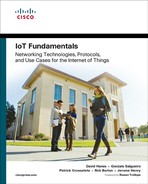Foreword
Greetings from the past. I am writing this foreword in what is for you the bygone technological era of February 2017. Back then (or now, to me), most cars still had human drivers. We still needed traffic lights, and most of those lights ran on timers, completely blind to the traffic on the streets. As I write this, most residential utility meters are mechanical, and utility workers have to walk from house to house to get readings. The vast majority of toasters can’t tweet.
I joined Cisco in 2013 and became the company’s Internet of Things leader in 2015. The scope and velocity of the technological change my team sees is immense—so much so that book forewords can have a short shelf life.
But we can prepare for the changes and opportunities that are coming at us. We will have to use different tools from the ones we used to build the current Internet. We need a rock-solid understanding of the fundamentals of the Internet of Things: Where we are today, the challenges we face, and where those opportunities lie. Cisco’s most knowledgeable engineers and top technical talent wrote this book so we could build toward this future together.
Where Things Are
I expect this book to be a useful tool for you, even if you don’t pick it up until 2020, when the number of “Internet of Things” (if we still call it that) devices might have reached 50 billion, from a paltry 6.4 billion in 2016. Manufacturing plants will be smarter and more efficient than they’ve ever been, thanks to their capabilities to process, share, and react to sensor information and other data. Complex machines like cars will be comprehensively metered, down to the component level, with their massive data streams fanning out into vast analytics systems that serve life-safety, ecological, and financial services—and even the manufacturing plants that made them—in real time. The things will become so smart—tractors, teacups, tape measures—that the product companies will be transformed into services companies.
It will have been the biggest technology transition the world has ever seen.
Currently, the networking protocols to collect and collate and analyze and transmit that data are still evolving—fast. We have a robust and stable Internet, but it was built to connect people and general-purpose computers, not billions of highly specialized devices sending out constant streams of machine data.
Our global network is designed to mimic point-to-point connectivity, and it is, for the most part, neutral to the devices that connect to it and to the types of data they are designed to send and receive. Currently, several companies, including Cisco, are coming up with ways to add a layer of mediation between the billions of devices coming online and the data and analytical warehouses that will be the repositories of their data for business and other applications. (We call this layer “the edge,” for now.)
Since a lot of the data and telemetry that devices create will need to be sent wirelessly, we’re also doing what we can to improve the reliability and speed of data transfer, as well as to lower its latency and the power it takes to send each bit. There are several emerging wireless standards in this race. And in a few years, there will still be several—because different types of devices and applications will need different things from their wireless systems. Currently, the mobile carriers are the big players that are being joined by the largest consumers of data services, like the energy and transportation companies. The next few years are going to see a lot of competition and innovation as old and new companies compete to be the transporters of all this information.
We’re also working to make sure that IoT devices themselves can strengthen the security of the networks they use. Right now (in your past), the network itself has very limited knowledge of what types of data it should be sending and what it should not be. Devices can get hijacked to attack other devices—or the network itself. By the time you read this, I am confident that this security problem along with other IoT challenges, such as scalability and interoperability issues, will be closer to getting solved. This book will help us get there. It is an educational resource that captures the fundamentals of IoT in a coherent and comprehensive manner. IoT is poised to change our world, and this book provides the necessary foundation for understanding and navigating the shifting IoT landscape.
The Adoption Curve
From my vantage point in 2017, it’s clear we have a lot of work ahead of us to make the Internet of Things into a fabric that all businesses can easily connect to. I’m sure it’s going to get done, though. And soon. I know this because we’re building the tools ourselves here at Cisco and because I talk all the time to business leaders and entrepreneurs who are betting their companies on IoT-powered processes.
Building IoT solutions, keeping them safe, making them inexpensive and maintainable, and processing and profiting from the data they generate are all enormous opportunities. My team’s job is to make all these jobs easier for you, and it all starts with education—ours and yours.
— Rowan Trollope, SVP and GM of IoT and Applications Groups, Cisco
